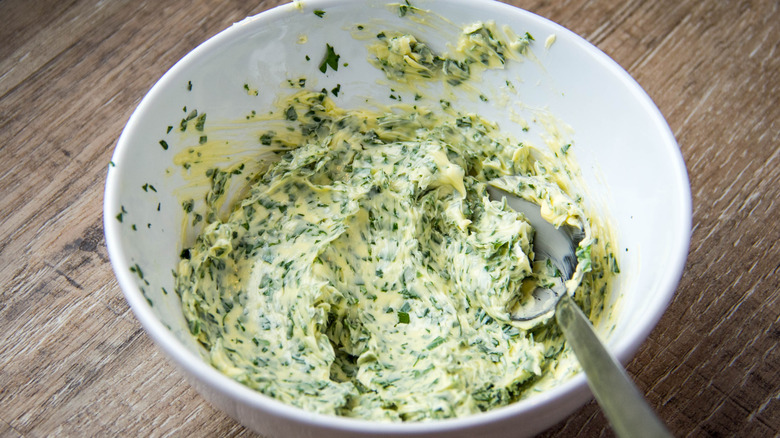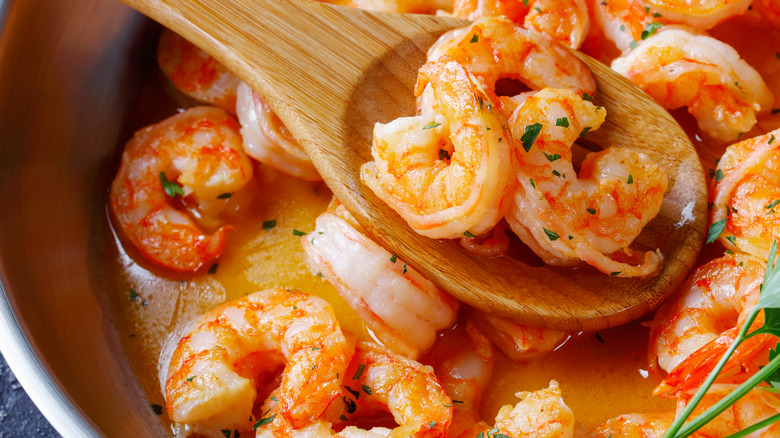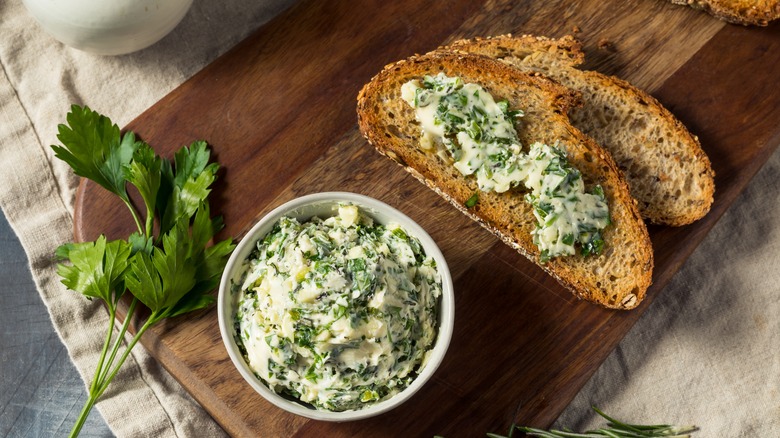The Seafood Butter You Should Always Have In The Fridge
Most people would agree that while seafood is enjoyable on its own, the addition of butter makes it all the more appetizing. Usually, it's in the form of clarified butter — unsalted butter that has been melted down until the water evaporates and the milk solids sink to the bottom of the pan. When you strain out the milk solids and skim the foam on top, what's left is the clarified butter, sometimes called ghee. Clarified butter, Savory Simple explains, is usually served with seafood because it adds fat yet doesn't have an overpowering flavor.
Clarified butter may be ideal for seafood boils, crab legs, and other crustaceans, but it isn't necessarily the best butter option for all seafood dishes. Grilled oysters and seared scallops, for example, pair better with browned butter (per the James Beard Foundation), while seafood pastas often call for some sort of garlic butter. If you tend to cook a lot of seafood, there's one type of butter you'll want to have on hand that's versatile enough for a wide range of both seafood and non-seafood applications.
What is scampi butter?
Scampi, according to The Modern Proper, means langoustine in Italian, but scampi butter actually has no crustacean in it at all. Instead, it shares most of its ingredients with scampi pasta sauce. In addition to langoustine, which is normally substituted for shrimp, scampi pasta sauce contains butter, olive oil, fresh parsley, lemon juice, red pepper flakes, garlic, and dry white wine. According to Upstream Fish, scampi butter contains many of the same ingredients, but green onion is added, olive oil is left out, and rather than wine, it's a wine reduction.
To use scampi butter for shrimp scampi, per Upstream Fish's instructions, you simply combine a fourth cup of butter for every half pound of shrimp. Though it's designed with seafood in mind, scampi butter is essentially a compound butter, and therefore, as Food & Wine points out, it can be used in any savory dish. The publication recommends adding it to vegetables and meats for a boost of flavor, and Upstream fish even suggests spreading it on some garlic bread.
How to make scampi butter
There are plenty of online retailers that sell scampi butter, and you may also be able to find the product at a gourmet food store along with the truffle butter and other specialty spreads. But if you're not willing to drop as much as $10 for just two sticks (via The Daily Catch), homemade scampi butter can be just as tasty.
When making any sort of compound butter, the temperature matters, The Tasty Travelers notes, and scampi butter is no exception. While melted butter technically makes the mixing process easier, it sadly doesn't firm up well. Unless you constantly stir it as it cools, you'll end up with pockets of oil, and the mix-ins won't be dispersed evenly throughout the butter. For best results, you'll want to use room temperature butter instead. As for the ratio of butter to mix-ins, you can stick with the proportions of any scampi sauce recipe and substitute the olive oil for butter. Alternatively, per MyRecipes' recommendation, you can start with a stick of butter, four teaspoons of garlic, and one tablespoon of parsley, and add other ingredients to your liking. Whether you make it from scratch or buy it from the store, scampi butter is sure to be a tasty addition to many dishes.


